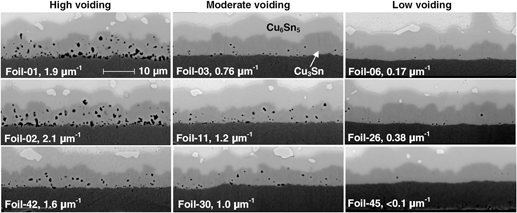Crossref Citations
This article has been cited by the following publications. This list is generated based on data provided by
Crossref.
Borgesen, Peter
Yin, Liang
and
Kondos, Pericles
2011.
Assessing the risk of “Kirkendall voiding” in Cu3Sn.
Microelectronics Reliability,
Vol. 51,
Issue. 4,
p.
837.
Yang, Yang
Lu, Hao
Yu, Chun
and
Li, Yongzhi
2011.
Void formation at the interface in Sn/Cu solder joints.
Microelectronics Reliability,
Vol. 51,
Issue. 12,
p.
2314.
Yin, Liang
Wafula, Fred
Dimitrov, Nikolay
and
Borgesen, Peter
2012.
Toward a Better Understanding of the Effect of Cu Electroplating Process Parameters on Cu3Sn Voiding.
Journal of Electronic Materials,
Vol. 41,
Issue. 2,
p.
302.
Ho, C.E.
Kuo, T.T.
Gierlotka, W.
and
Ma, F.M.
2012.
Development and Evaluation of Direct Deposition of Au/Pd(P) Bilayers over Cu Pads in Soldering Applications.
Journal of Electronic Materials,
Vol. 41,
Issue. 12,
p.
3276.
Yang, Chaoran
and
Lee, S. W. Ricky
2012.
Investigation of fracture behaviors of Cu-Sn intermetallics using impact test.
p.
1.
Yu, Chun
Yang, Yang
Wang, Kaiyun
Xu, Jijin
Chen, Junmei
and
Lu, Hao
2012.
Relation between Kirkendall voids and intermetallic compound layers in the SnAg/Cu solder joints.
Journal of Materials Science: Materials in Electronics,
Vol. 23,
Issue. 1,
p.
124.
Borgesen, Peter
Yin, Liang
and
Kondos, Pericles
2012.
Acceleration of the growth of Cu3Sn voids in solder joints.
Microelectronics Reliability,
Vol. 52,
Issue. 6,
p.
1121.
Wafula, F.
Yin, L.
Borgesen, P.
Andala, D.
and
Dimitrov, N.
2012.
Influence of Poly(ethylene glycol) Degradation on Voiding Sporadically Occurring in Solder Joints with Electroplated Cu.
Journal of Electronic Materials,
Vol. 41,
Issue. 7,
p.
1898.
van de Wiel, H. J.
Vardoy, A-S. B.
Hayes, G.
Fischer, H. R.
Lapadatu, A.
and
Taklo, M. M. V.
2012.
Characterization of hermetic wafer-level Cu-Sn SLID bonding.
p.
1.
Chuang, H. Y.
Yang, T. L.
Kuo, M. S.
Chen, Y. J.
Yu, J. J.
Li, C. C.
and
Kao, C. Robert
2012.
Critical Concerns in Soldering Reactions Arising from Space Confinement in 3-D IC Packages.
IEEE Transactions on Device and Materials Reliability,
Vol. 12,
Issue. 2,
p.
233.
Ho, Cheng En
Kuo, Tsai Tung
Wang, Chun Chien
and
Wu, Wei Hsiang
2012.
Inhibiting the growth of Cu3Sn and Kirkendall voids in the Cu/Sn-Ag-Cu system by minor Pd alloying.
Electronic Materials Letters,
Vol. 8,
Issue. 5,
p.
495.
Wang, Yiwei
Chae, Seung-Hyun
Dunne, Rajiv
Takahashi, Yoshimi
Mawatari, Kazuaki
Steinmann, Philipp
Bonifield, Tom
Jiang, Tengfei
Im, Jay
and
Ho, Paul S.
2012.
Effect of intermetallic formation on electromigration reliability of TSV-microbump joints in 3D interconnect.
p.
319.
Chen, Bangtao
Sekhar, Vasarla Nagendra
Jin, Cheng
Lim, Ying Ying
Toh, Justin See
Fernando, Sanchitha
and
Sharma, Jaibir
2013.
Low-Loss Broadband Package Platform With Surface Passivation and TSV for Wafer-Level Packaging of RF-MEMS Devices.
IEEE Transactions on Components, Packaging and Manufacturing Technology,
Vol. 3,
Issue. 9,
p.
1443.
Kim, S.H.
and
Yu, Jin
2013.
Heat-treatment to suppress the formation of Kirkendall voids in Sn-3.5Ag/Cu solder joints.
Materials Letters,
Vol. 106,
Issue. ,
p.
75.
Luu, Thi-Thuy
Duan, Ani
Wang, Kaiying
Aasmundtveit, Knut
and
Hoivik, Nils
2013.
Cu/Sn SLID wafer-level bonding optimization.
p.
1531.
Son, Ho-Young
Noh, Sung-Kwon
Jung, Hyun-Hee
Lee, Woong-Sun
Oh, Jae-Sung
and
Kim, Nam-Seog
2013.
Reliability studies on micro-bumps for 3-D TSV integration.
p.
29.
Ismathullakhan, Shafiq
Lau, Hungyin
and
Chan, Yan-cheong
2013.
Enhanced electromigration reliability via Ag nanoparticles modified eutectic Sn–58Bi solder joint.
Microsystem Technologies,
Vol. 19,
Issue. 7,
p.
1069.
Wang, S. J.
Hsu, L. H.
Wang, N. K.
and
Ho, C. E.
2014.
EBSD Investigation of Cu-Sn IMC Microstructural Evolution in Cu/Sn-Ag/Cu Microbumps During Isothermal Annealing.
Journal of Electronic Materials,
Vol. 43,
Issue. 1,
p.
219.
Chiu, Wei-Lan
Liu, Chien-Min
Haung, Yi-Sa
and
Chen, Chih
2014.
Formation of nearly void-free Cu3Sn intermetallic joints using nanotwinned Cu metallization.
Applied Physics Letters,
Vol. 104,
Issue. 17,
Yu, Chun
Yang, Yang
Chen, Jieshi
Xu, Jijin
Chen, Junmei
and
Lu, Hao
2014.
Effect of deposit thickness during electroplating on Kirkendall voiding at Sn/Cu joints.
Materials Letters,
Vol. 128,
Issue. ,
p.
9.





